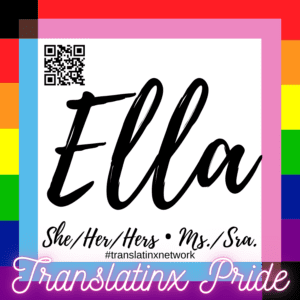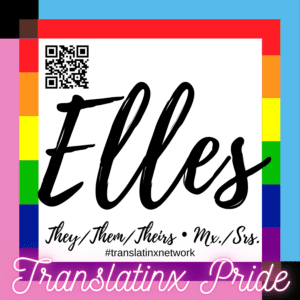TGNC Basics
Frequently Asked Questions
Let's start with the most frequently asked questions about Personal Gender Pronouns (PGPs).
Pronouns -- we all use them as part of everyday conversation. A pronoun is a word that refers to either the people talking (like “I” or “you”) or someone or something that is being talked about (like “she,” “it,” “them,” and “this”).
Gender pronouns (such as “he/him/his” and “she/her/hers”) refer to people that you are talking about. Gender pronouns are the way that we constantly refer to each other’s gender identity - except we often don’t think a whole lot about them. Usually we interpret or “read” a person’s gender based on their outward appearance and expression, and “assign” a pronoun. But our reading may not be a correct interpretation of the person’s gender identity.
Because gender identity is internal -- an internal sense of one’s own gender -- we don’t necessarily know a person’s correct gender pronoun by looking at them. Additionally, a person may identify as genderfluid or genderqueer and may not identify along the binary of either male or female (e.g. “him” or “her”). Some people identify as both masculine and feminine, or neither. A genderqueer or non-binary identified person may prefer a gender-neutral pronoun such as the “they” (e.g. “I know Sam. They work in the Accounting Department”).
From: https://assets2.hrc.org/files/assets/resources/TalkingAboutPronouns_onesheet_FINAL.pdf
Nothing may be more personal than the way in which people refer to us through our name and pronouns. Using a person’s chosen name and desired pronouns is a form of mutual respect and basic courtesy.
The experience of being misgendered can be hurtful, angering, and even distracting. The experience of accidentally misgendering someone can be embarrassing for both parties, creating tension and leading to communication breakdowns.
It’s important to remember that gender identity is not visible -- it’s an internal sense of one’s own gender. While most people align across their birth-assigned sex, their gender identity, their gender expression and how everyone else interprets their gender -- some people do not. A culture that readily asks or provides pronouns is one committed to reducing the risk of disrespect or embarrassment for both parties.
From: https://assets2.hrc.org/files/assets/resources/TalkingAboutPronouns_onesheet_FINAL.pdf
Start by giving your own – for example, "My pronouns are she/her."
If I was introducing myself to someone, I would say, "I'm David. I use he/him pronouns. What about you?"
It may feel awkward at first, but eventually it just becomes another one of those get-to-know-you questions.
From: NPR Guide
She/her/hers and he/him/his are a few commonly used pronouns. Some people call these “female/feminine” and “male/masculine” pronouns, but many avoid these labels because not everyone who uses he feels like a “male” or “masculine.”
There are also lots of gender-neutral pronouns in use. Here are a few you might hear:
- They/them/theirs (Shea ate their food because they were hungry.) This is a pretty common gender-neutral pronoun and it can be used in the singular. In fact, “they” was voted as the Word of the Year in 2015.
- Ze/hir/hir (Tyler ate hir food because ze was hungry.) Ze is pronounced like “zee” can also be spelled zie or xe, and replaces she/he/they. Hir is pronounced like “here” and replaces her/hers/him/his/they/theirs.
- Just my name please! (Ash ate Ash’s food because Ash was hungry) Some people prefer not to use pronouns at all, using their name as a pronoun instead.
Never refer to a person as “it” or “he-she”. These are offensive slurs used against trans and gender non-conforming individuals.
Simply apologize and move on.
Misgendering refers to the experience of being labeled by others as a gender other than one that a person identifies with. Because many (not all) associate their pronouns with their gender identity, using the wrong pronouns intentionally or unintentionally is a form of misgendering. If you accidentally use the wrong pronoun when identifying someone, please apologize or say “thank you”, and immediately use the right pronoun.
i.e. This is Alex, she is one of my science students. (you are corrected because Alex uses they/them/theirs pronouns). Sorry, they are one of my science students. Or Thank you, they are one of my science students.
Everyone makes mistakes, please take accountability for your mistake and continue using the correct pronoun. The important thing to be mindful of, is to not unload your guilty feelings on transgender, nonbinary, and gender nonconforming people or expect forgiveness. They might have a strong reaction to the misuse of their pronouns and need space to recenter themselves.
We would like to offer you some tips for getting used to using gender-inclusive language:
- Practice, practice, practice! Use gender-neutral pronouns such as “they” and “ze” while visualizing the person who uses them. This is especially useful to do right before you’re about to see the person.
- When addressing groups of people or people whose pronouns you haven’t been told, use gender-neutral language such as, “siblings,” “third graders,” “students”, “friends,” “folks,” “all,” or “y’all,” rather than “brothers and sisters,” or “guys,” “ladies,” “ma’am,” or “sir.”
- Use descriptive language if you do not know a person’s gender, pronouns, or name. e.g. Can you give this paper to the person across the room with the white t-shirt and short brown hair?
Share this resource with others and open conversations and support to make sure you are engaging in respecting people’s identities and pronouns. Growing and learning takes time! Educate, engage, emend!
Visit some of the organizations' pages listed in some of the previous questions. You can also download and print the New York City Department of Social Services Gender Pronouns guidelines here: https://www1.nyc.gov/assets/hra/downloads/pdf/services/lgbtqi/Gender%20Pronouns%20final%20draft%2010.23.17.pdf



